

Moodle. Collaborative online learning. Special Ed. Simple Techniques for Applying Active Learning Strategies to Online Course Videos. From Web-enhanced face-to-face courses to MOOCs, flipped, blended, and fully online courses, videos are an integral component of today’s educational landscape—from kindergarten all the way through higher education.

But there’s a big difference between watching a video and learning something from it. Videos are great for presenting visual information and emotional appeals, but not particularly effective at diving below the surface of non-visual theoretical or abstract topics or for driving critical thinking. What’s more, any video presented in class must compete for attention and memory with the five-plus hours the typical student spends outside of class watching television programs, movies, and other onscreen entertainment. (Nielsen, 2013) To help increase the educational effectiveness of an online course video, consider applying one or more of the following active learning strategies. 1.
A. Q. B. I. Ii. Iii. C. 2. A. B. I. Ii. Iii. Iv. How to Increase Speed to Competency with Blended Learning. During the employee onboarding process, time counts—so how can you make the most of everyone’s time while onboarding employees?

The goal is to improve speed to competency to ensure employees are indispensable members of the company as quickly as possible. Our suggestion: blended learning. The stakes are high for getting your employee onboarding right, and company profitability rely on employees who can propel their company’s objectives forward. The Aberdeen Group found that organizations that had a standardized onboarding process had 57% new hire retention, compared to 38% retention in companies that did not have a standardized onboarding process [1]. In the same study, the Aberdeen Group also found that new hire engagement was at 36% in standardized onboarding, compared to 17% in non-standardized onboarding. Digital Training Resources on Technology-enabled Learning.
Effective Instructional Strategies That Boost Learning. Instructional strategies include all approaches that a teacher may take to engage students in the learning process actively.
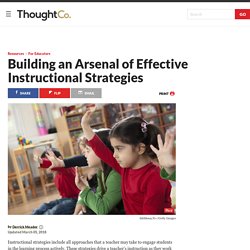
These strategies drive a teacher's instruction as they work to meet specific learning objectives and ensure that their students are equipped with the tools they need to be successful. Effective instructional strategies meet all learning styles and the developmental needs of all learners. 32 Research-Based Instructional Strategies - 32 Research-Based Instructional Strategies by TeachThought Staff You want to teach with what’s been proven to work.
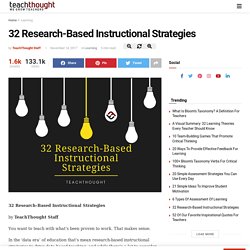
That makes sense. Research-Based Instructional Strategies. Marzano's High Yield Instructional Strategies. Instructional Strategy Videos - Differentiating Instruction. Effective Instructional Strategies:Teaching Sequential Skills. 5 Instructional Design Strategies for Creating Better E-learning. Glossary of Instructional Strategies. Current number of strategies and methods: 1271 Last updated: 27 July, 2013 Definitions written by Kelly Jo Rowan. ©1996-2013 Kelly Jo Rowan. 10 + 2 (Ten Plus Two) Direct instruction variation where the teacher presents for ten minutes, students share and reflect for two minutes, then the cycle repeats. 1st TRIP (First TRIP) A reading strategy consisting of: Title, Relationships, Intent of questions, Put in perspective. 3-2-1 (Three-Two-One) Writing activity where students write: 3 key terms from what they have just learned, 2 ideas they would like to learn more about, and 1 concept or skill they think they have mastered. 5 + 1 (Five Plus One) Direct instruction variation where the teacher presents for five minutes, students share and reflect for one minute, then the cycle repeats.
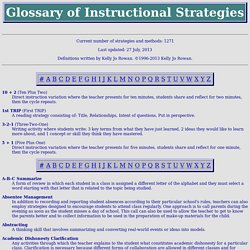
A-B-C Summarize A form of review in which each student in a class is assigned a different letter of the alphabet and they must select a word starting with that letter that is related to the topic being studied. Acronyms. Instructional Strategies List for Teachers. A BIG List of Instructional Strategies for Teachers I’ve decided to create an instructional strategies list for teachers.
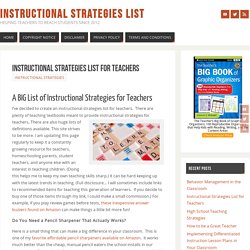
There are plenty of teaching textbooks meant to provide instructional strategies for teachers. There are also huge lists of definitions available. This site strives to be more. Do You Need a Pencil Sharpener That Actually Works? Here is a small thing that can make a big difference in your classroom. I always ask if anyone needs their pencil sharpened at the beginning of class. X-ACTO School Pro Classroom Electric Pencil Sharpener, Blue, 1 Count (1670)See This on Amazon! The list below is a curated collection of links to resources, informative videos, and basic pedagogical definitions that I’ve spent weeks (so far) putting together. The Big List. A List Of 50+ Teaching Strategies To Jumpstart Your Teacher Brain. Teaching strategies are among the most important ingredients for highly-effective learning environments.
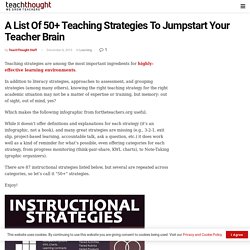
In addition to literacy strategies, approaches to assessment, and grouping strategies (among many others), knowing the right teaching strategy for the right academic situation may not be a matter of expertise or training, but memory: out of sight, out of mind, yes? Which makes the following infographic from fortheteachers.org useful. While it doesn’t offer definitions and explanations for each strategy (it’s an infographic, not a book), and many great strategies are missing (e.g., 3-2-1, exit slip, project-based learning, accountable talk, ask a question, etc.) it does work well as a kind of reminder for what’s possible, even offering categories for each strategy, from progress monitoring (think-pair-share, KWL charts), to Note-Taking (graphic organizers). 20 Differentiated Instruction Strategies & Examples. As students with diverse learning styles fill the classroom, many teachers don’t always have the time to plan lessons that use differentiated instruction (DI) to suit their distinct aptitudes.
This can involve adjusting: Content — The media and methods teachers use to impart and instruct skills, ideas and informationProcesses — The exercises and practices students perform to better understand contentProducts — The materials, such as tests and projects, students complete to demonstrate understanding To help create lessons that engage and resonate with a diverse classroom, below are 20 differentiated instruction strategies and examples.
Available in a condensed and printable list for your desk, you can use 16 in most classes and the last four for math lessons. Try the ones that best apply to you, depending on factors such as student age.